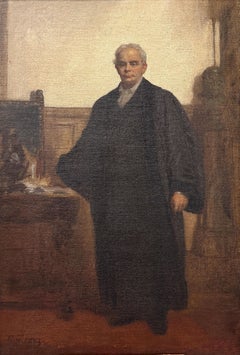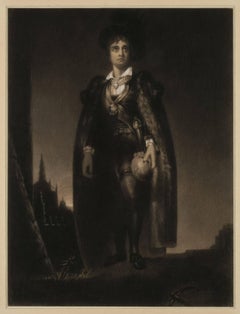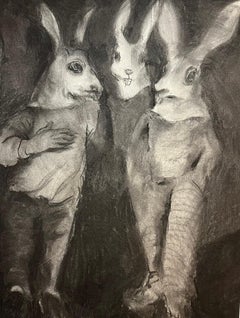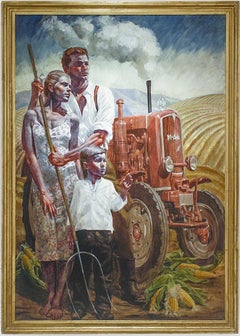Eastman Johnson Art
to
1
2
2
1
1
1
1
"John Van Schaick Lansing Pruyn" Eastman Johnson, Prominent Gentleman Portrait
By Eastman Johnson
Located in New York, NY
Eastman Johnson
John Van Schaick Lansing Pruyn, 1883
Initialed and dated lower left
Oil on canvas
28 x 18 inches
For many years the foremost genre painter in the United States, Eas...
Category
1880s Academic Eastman Johnson Art
Materials
Canvas, Oil
John Phillip Kemble as Hamlet, Act V, Scene I
By Eastman Johnson
Located in Fairlawn, OH
Signed and dated (on back) "January 1845/ J.E.J."
Provenance:
Mr. and Mrs. Bertram Rowland, Buckingham, PA
Mr. and Mrs. Edward Abraham, West Chester, PA
Hirschl & Adler Galleries...
Category
1840s Eastman Johnson Art
Materials
Charcoal
Related Items
Conspiracy Zahra Zeinali Contemporary drawing black and white art animal rabbit
By Zahra Zeinali
Located in Paris, FR
Charcoal on paper
Unique work
Hand-signed by the artist
Category
2010s Contemporary Eastman Johnson Art
Materials
Paper, Charcoal
$2,963
H 25.6 in W 19.69 in
Prosperous Family: Academic Figurative Painting by Mark Beard aka Bruce Sargeant
By Mark Beard
Located in Hudson, NY
Academic style figurative painting on canvas of a family and red tractor against a classic American farm field
"Prosperous Family", painted by Mark Beard under his fictitious persona, Bruce Sargeant
84 x 58 inches unframed, 91 x 65 x 3 inches with a gold painted wood frame
Excellent condition, ready to hang as is
This Academic style figurative oil painting on canvas was painted by Mark Beard as Bruce Sargeant, a pseudonym in homage to the fashion photographer, Bruce Weber, and figurative painter, John Singer Sargeant. Here, the artist captures a blue collar American farming family in their field with an old red tractor. The man and woman stand stoically with their young child, dressed in simple white garments, perhaps to symbolize their purity. Rolling mountains...
Category
Early 2000s Academic Eastman Johnson Art
Materials
Canvas, Oil
$12,000
H 91 in W 65 in D 3 in
Untitled Portrait II (Modern, Academic Style Portrait Painting of a Young Man)
By Mark Beard
Located in Hudson, NY
Modern, academic style portrait painting on canvas of a young athletic male
oil on canvas, 26 x 17 inches in antique wood frame
This vertical, contemporary portrait painting of sin...
Category
2010s Academic Eastman Johnson Art
Materials
Canvas, Oil
$3,400
H 26 in W 17 in D 1.5 in
Self Portrait
By Sándor Bortnyik
Located in London, GB
Charcoal on paper, signed and dated (lower right), 33cm x 24cm, (66cm x 56cm framed). The work is framed behind UV glass and stepped gilded frame.
Bortnyik was a painter and graphi...
Category
1910s Bauhaus Eastman Johnson Art
Materials
Paper, Charcoal
Old Time Football in the 1920s - Football 1920s - Classic Football
By Walt Louderback
Located in Miami, FL
You Got to be a Football Hero to Get Along with a Beautiful Girl. Masterfully composed and dynamic illustration that show a player getting punched in the jaw. During this period, there were no face...
Category
1920s Academic Eastman Johnson Art
Materials
Canvas, Oil
$10,000
H 18.8 in W 32 in
Ready to Play (Academic Figurative Painting of Male Athlete by Mark Beard)
By Mark Beard
Located in Hudson, NY
Academic style figurative oil painting of a handsome football player against a country landscape
'Ready to Play', Painted by Mark Beard as Bruce Sargeant (pseudonym in homage to the...
Category
2010s Academic Eastman Johnson Art
Materials
Canvas, Oil
$3,500
H 26 in W 22 in D 1.5 in
Portrait of an Elegant Young Woman in Warm Grays and Soft Ochers
By Leon Kroll
Located in Miami, FL
Leon Kroll was above all an academician. To him "abstract art was merely the beginning of a picture. Structurally, "Portrait of a Young Woman recalls some of the portraits from the ...
Category
1930s Academic Eastman Johnson Art
Materials
Canvas, Oil
$18,000
H 18 in W 15 in
Virgin Mary and Child Jesus oil on canvas painting
Located in Sitges, Barcelona
Title: Virgin Mary and Child Jesus
Artist: Francisco Ribera Gómez (1907-1990)
Technique: Oil on canvas
Dimensions: 31.9 x 25.6 inches (unframed)
Date of creation: 1942
Style: Classical Academicism with Renaissance influences
Description of the Artwork
The painting depicts the Virgin Mary holding the Child Jesus in a tender and intimate moment. Warm colors, primarily reds, greens, and soft flesh tones, enhance the devotional nature of the scene. The use of golden halos, symbolizing sanctity, along with serene and realistic expressions, directly connects with the Renaissance pictorial tradition.
The style belongs to classical academicism, characterized by a balanced composition, meticulous drawing, and a masterful use of chiaroscuro to give volume and depth to the figures. The detailed rendering of the flesh tones and draperies amplifies the spirituality and solemnity of the piece, evoking the works of great masters such as Raphael and Murillo.
Artist's Biography
Francisco Ribera Gómez (1907-1990) was a prominent 20th-century Spanish painter known for his depictions of religious scenes, female portraits, and costumbrist works. Trained at the Royal Academy of Fine Arts of San Fernando, Ribera Gómez received numerous accolades and was regarded as one of the great exponents of Spanish academicism. His work combines a rigorous technical foundation with luminous sensitivity and an idealized sense of beauty.
Influences and Comparisons
Francisco Ribera Gómez's work can be compared to other academic and religious artists who share a similar aesthetic:
Bartolomé Esteban Murillo: In the emotional and approachable treatment of religious themes.
William-Adolphe Bouguereau: For the idealization of human figures and technical mastery.
Raphael (Raffaello Sanzio): For harmonious composition and the depiction of the Virgin Mary.
Within the Spanish tradition, his style recalls Eduardo Rosales...
Category
1940s Academic Eastman Johnson Art
Materials
Oil, Canvas
$1,420 Sale Price
52% Off
H 31.89 in W 25.6 in
Jean – Gabriel DOMERGUE (1889 – 1962), "Elegant Lady with Parasol and Dog"
Located in Paris, FR
Jean-Gabriel Domergue (1889–1962) was a renowned French painter and engraver, celebrated especially for his portraits of elegant women or, more precisely, a feminine figure in a styl...
Category
1920s Art Deco Eastman Johnson Art
Materials
Paper, Charcoal, Watercolor, Gouache, Pencil
$9,467
H 19.49 in W 12.41 in
Original painting for JOB cigarettes advert, 1900, by French artist Gervais
Located in Petworth, West Sussex
Paul Gervais was one of the most highly regarded painters of the female form in the late 19th Century but this is one of his most famous images as it was used in the advertising camp...
Category
19th Century Academic Eastman Johnson Art
Materials
Canvas, Oil
$11,402
H 24 in W 18.13 in D 1 in
A Pompeian Lady
By John William Godward
Located in New Orleans, LA
John William Godward
1861-1922 British
A Pompeian Lady
Signed and dated "J.W. Godward 1904" (lower right, partially covered by frame)
Oil on canvas
One of the last and greatest Victorian neoclassical painters, John William Godward is celebrated for his flawlessly executed images of graceful women posed in idealized ancient settings. In this work, entitled A Pompeian Lady, a classical beauty is caught idling in a moment of quiet, solitary reflection. Godward's elegant subjects are depicted with a degree of technical mastery that remains unsurpassed, and the work's dramatic palette, luxurious fabrics and classical vision are all characteristics of his unique take on the neoclassical style.
Godward was unmatched in terms of his technical skill and attention to detail. A master of contrasting textures, he paints a diaphanous gown draping against the model’s smooth, milky white skin, which sits against the painstakingly rendered individual hairs of a tiger’s pel. Scintillating color permeates the canvas as well, energizing the otherwise static scene. Each element is given careful attention, and the overall effect is one of both immaculate technique and sensual tactility.
Along with his contemporary and mentor, Sir Lawrence Alma-Tadema, Godward set the tone for the Victorian neoclassicist movement. He built his career upon creating images of idealized feminine beauty infused with a Greco-Roman-inspired style. Though greatly influenced by Alma-Tadema, Godward distinguished himself through his predilection for the solitary female figure. His fame rose dramatically in the first few years of the 20th century, when the present work was completed, due to the burgeoning strength of the British Empire and the Victorian society’s preoccupation with ancient Rome. To many of the newly affluent, Roman society was, as Iain Gale writes, “a flawless mirror of their own immaculate world.” The sensuality and mystery of Godward’s maidens, combined with his impressive antique backdrops...
Category
Early 20th Century Academic Eastman Johnson Art
Materials
Canvas, Oil
La Fille Du Pêcheur By William Bouguereau
By William-Adolphe Bouguereau
Located in New Orleans, LA
William-Adolphe Bouguereau
1825-1905 French
La fille du pêcheur
(The Fisherman’s Daughter)
Signed and dated “W-Bouguereau-1882” (middle right)
Oil on canvas
William Bouguereau's...
Category
19th Century Academic Eastman Johnson Art
Materials
Canvas, Oil
$1,985,000
H 67.13 in W 44.75 in D 2.25 in
Eastman Johnson art for sale on 1stDibs.
Find a wide variety of authentic Eastman Johnson art available for sale on 1stDibs. You can also browse by medium to find art by Eastman Johnson in charcoal and more. Not every interior allows for large Eastman Johnson art, so small editions measuring 24 inches across are available. Customers who are interested in this artist might also find the work of Jaro Fabry, Bradshaw Crandell, and Tony Johannot. Eastman Johnson art prices can differ depending upon medium, time period and other attributes. On 1stDibs, the price for these items starts at $24,000 and tops out at $24,000, while the average work can sell for $24,000.



